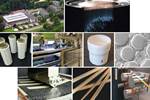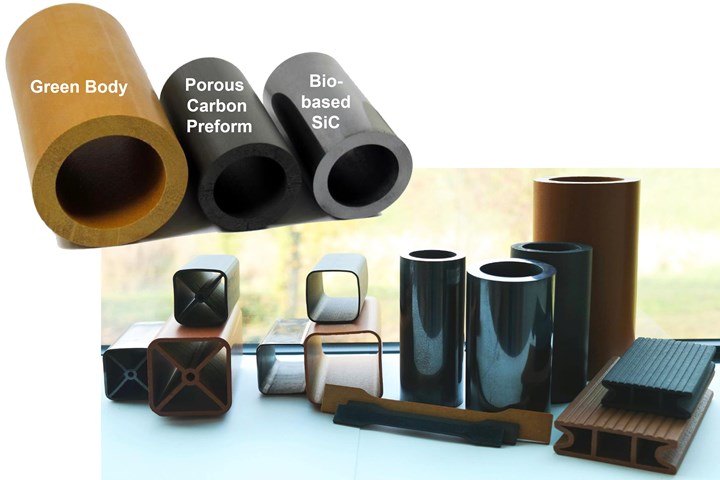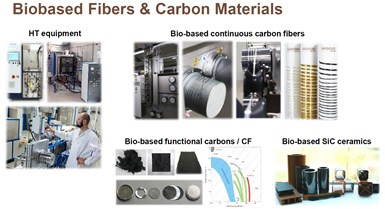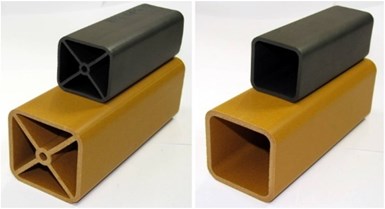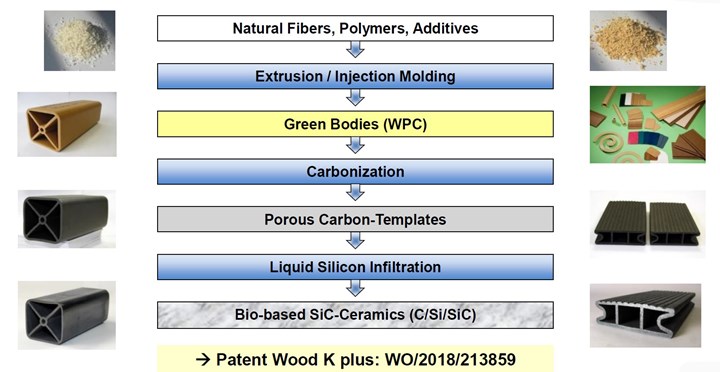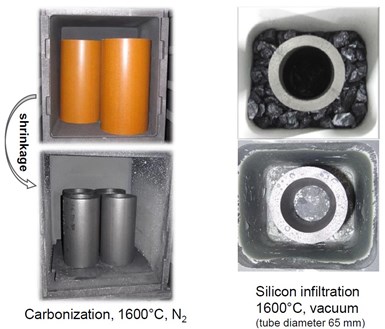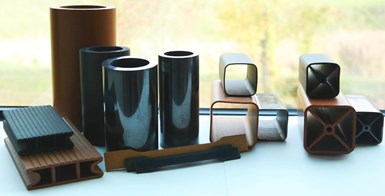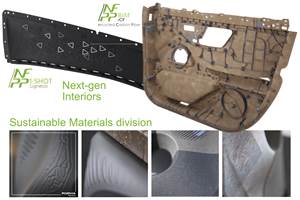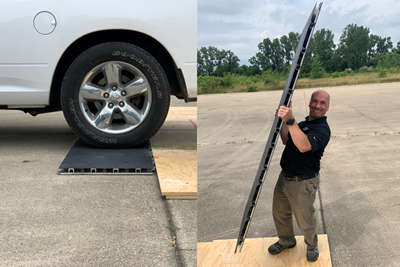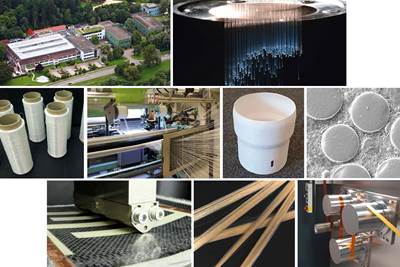Bio-based SiC ceramics from wood polymer composites
Austrian research institute Wood K plus makes 95% silicon carbide ceramics more sustainable (>85% bio/recycled content), enables 3D shapes via extrusion, injection molding and 3D printing.
Share
Read Next
An extruded wood polymer composite (WPC) green body that has then been carbonized into a porous preform and then processed via silicon melt infiltration into a high-performance silicon carbide (SiC) ceramic using a patented process developed by Wood K plus. Photo credit: Wood K plus
Wood K plus (Linz, Austria) is a research institute founded in 2000 as the competence center for bio-based materials in Austria. “We started as a competence center for wood chemistry and wood composites,” explains Christoph Unterweger, team leader, fibers, carbon and ceramics. “But we now focus on quite a broad range of topics regarding bio-based materials and resource efficient processes.
Wood K plus comprises three divisions (top) and performs a wide range of R&D that involves composites (bottom). Photo credit: Wood K plus
Wood K plus comprises three divisions in three locations:
- Biorefinery Processes and Composite Materials (Linz)
- Wood Materials Technologies (Tulln)
- Smart Composites and Surfaces (St. Veit)
“We generally cover the whole value chain, including raw materials, processing and testing of bio-based products,” says Unterweger. “In this case, due to our long-term experience in extrusion of thermosets, our focus was on short fiber composites. In our next steps, this will be accompanied by LCA, sLCA and LCC [lifecycle assessment, social LCA and lifecycle costing] which are topics we have also been developing for almost 15 years and which are becoming more and more important.”
Unterweger, key researcher Christian Fuerst and their colleagues, have published research on “Bio-based carbon preforms for the manufacture of high-performance composites” and “Bio-based silicon carbide ceramics from thermoset-based wool wood polymer composites” as part of the BioC4HiTech project (2021-2023) funded through the Austrian Production of the Future program. “We can produce a high-strength, high-stiffness ceramic that is up to 95 wt% pure silicon carbide [SiC] from a preform that is 50-60 wt% wood,” says Unterweger. Turning wood into charcoal is familiar, but it’s surprising that a shaped wood polymer composite (WPC) could be transformed into a high-quality SiC ceramic. Note, SiC/SiC ceramic matrix composites (CMC) are now used for high-performance, high-temperature (1,200-1,600°C) parts in power turbines and jet engines (see “A new era for ceramic matrix composites”).
Porous carbon preforms from biomaterials
Unterweger says this was one of his division’s first topics, in 2010. “We developed a thermoset resin-based formulation that can be extruded, with the idea to use such systems as preforms for carbons for CMC.”
The BioC4HiTech project sought to produce bio-based green bodies for processing into metal, ceramic and carbon matrix composites. Photo credit: Wood K plus
In the BioC4HiTech project, this goal was expanded to produce bio-based green bodies that could then be carbonized into semi-finished (shaped and trimmed) preforms to be further processed into CMC, metal matrix composites (MMC) or what Wood K Plus calls CFC (carbon fiber-reinforced carbon) — and what CW would refer to as carbon/carbon (C/C), one of the most common types of CMC in addition to C/SiC and SiC/SiC. BioC4HiTech’s goal was to replace the fossil raw materials typically used in these composites — e.g., graphite and PAN/pitch-based carbon fiber — with natural fibers, lignin and/or recycled materials.
These materials are of interest to the second partner in this project, RHP Technology (Seibersdorf, Austria), a research group specializing in powder technologies and additive manufacturing, which is developing a wide range of novel materials, including electrically conductive and ultra-high temperature ceramics.
Potential applications of the metal, ceramic and carbon matrix composites (MMC, CMC, CFC) targeted for development within the BioC4HiTech project. Photo credit: Wood K plus
Wood K plus first used a melamine resin with wood reinforcement and extruded this into a 3D shape which was carbonized. “But melamine resins have a nitrogen content that is too high while the carbon content is too low,” says Unterweger. “So, we switched to a novolac phenolic resin and optimized for this system.”

“We used up to 60 wt% wood fibers as well as some thermoplastic additives to aid extrusion. We then cut 18-centimeter-long samples from the extrusion to fit in our small chamber furnace and heated it in nitrogen to 900°C. The thermoplastic vaporized to leave pores and the thermoset was converted to carbon, creating a porous preform.”
Wood K plus used Arbocel wood powder (left) and Lenzing cellulose fibers (right) to produce wood polymer composite green bodies. Photo credit: Agrobiobase.com, JRS and Lenzing
The wood reinforcement used initially was cellulose fiber from Lenzing with a length/diameter ratio (L/D) of 30, but due to shrinkage issues, Wood K plus switched to Arbocel C100 wood flour (L/D ratio <2).
Wood powder/polymer green bodies shrink 25-30% during conversion to porous carbon preforms, but without shape distortion. Photo credit: Wood K plus
It was expected the wood materials would shrink during carbonization. The issue with fibers is their orientation and thus shrinkage more in one direction. “The particles, however, have almost no L/D ratio,” explains Unterweger, “thus their 30% shrinkage occurs in each direction so that there is no distortion in the shape of the resulting carbon preform.”
WPC green bodies are first carbonized into preforms (left) and then infiltrated with liquid silicon (right). Photo credit: Wood K plus
The next step is to infiltrate the porous carbon preforms with silicon. “From the porosity you can determine how much silicon is needed to fill the preform,” explains Unterweger. “We placed the preforms and silicon flakes into a tool and then heat that again in the chamber furnace up to 1,600°C under vacuum. The silicon melts to a very low viscosity so that it infiltrates the pore structure and is distributed across the whole preform. And then, the silicon and carbon react to form silicon carbide.”
Quality, composition and protection from oxidation
The quality of the resulting SiC ceramic is determined by the composition and processing conditions of the WPC green body, notes Unterweger. “Composition and homogeneity of the mixture determine the porosity in the preform and this dictates the quality of the ceramic. We can achieve almost 95 wt% silicon carbide content, which is very high performance. There is almost no difference to a standard SiC ceramic.”
What is the temperature resistance of these more sustainable, bio-based SiC materials? Unterweger says 1,400°C is no problem. “Normally, SiC can go up to 2,300°C or perhaps a bit higher. And you can then come back down to a low temperature and repeat that cycle many times without destroying your material in any way. But because there is residual silicon (melting point 1,410°C) in our bio-based SiC ceramics, 1,400°C is the limit.”
In addition to the almost pure SiC, Wood K plus can also adjust the composition to have remaining carbon. “For example, we can have 20% by volume remaining carbon, depending on the wood particle size, which can add functionality, such as electrical conductivity or friction resistance,” says Unterweger.
But Wood K plus has noticed an interesting characteristic, in that the remaining carbon resulting from its process is encapsulated. The remaining carbon provides conductivity, while the other properties of the SiC are maintained. “We observed that if you just disperse some sort of carbon or graphite in the SiC matrix, that carbon is then just burnt away in an oxidative environment,” says Unterweger. “But the carbon in our process is somehow protected, so that it does not burn away. So, this is a key advantage — that we can control the composition but also achieve this sort of encapsulated carbon that is protected from oxidation.”
Shaping using other processes
Wood K plus started with extrusion due to its long history with the process. “But about 6-7 years ago, we also began working with injection molding and hot pressing,” notes Unterweger. This was easy to do with the WPC materials his team has developed. “We’re compounding, so we mix phenolic resin, plastic additives and the wood particles in an extruder and do some pelletizing,” he explains. “We can then either go again to the extruder and use some special tool to extrude a shaped green body that can have a very low wall thickness down to 3 millimeters, or we can just put this compound into a mold and do hot pressing to produce a plate from 40 millimeters in thickness down to 3 millimeters.”
WPC green bodies have also been made using 3D printing (top) and hot pressing, the latter enabling plates up to 30 millimeters thick (bottom). Photo credit: Wood K plus
Another interesting aspect, is that all of the machining can be done during the carbon preform stage, where there is much less wear on tools compare to after silicon infiltration when the SiC ceramic is much denser and harder. “If you wanted to machine very thick parts, this could be interesting,” adds Unterweger.
The BioC4HiTech project also produced parts using 3D printing. “This wasn’t using fused filament fabrication because there is no pre-made filament we can procure. Instead, we use the same pellets we have compounded and process these in an extrusion printer.” The 3D printing was actually done by RHP using an AIM3D machine (see Production-ready: Composite extrusion modeling (CEM) in the article “Metal AM advances in composite tooling, Part 2”).
For all of these processes, after the WPC green body is created, it is carbonized and then infiltrated with silicon to form the SiC ceramic. “So, we have a large variety of possible processes and material compositions,” says Unterweger. “And this includes low to high wood content, but higher wood content (40-60 wt%) produces the highest SiC content and thus the best performance as well as the highest share of renewable material. However, for injection molding and 3D printing, we are limited to 30-35 wt% wood particle content. Beyond that, the viscosity is too high and material flow is insufficient.”
Advantage, sustainability, potential path toward CMC?
Wood K plus can produce a range of WPC material compositions and shapes and convert these into SiC ceramics. Photo credit: Wood K plus
“Our main advantage is improved sustainability,” says Unterweger. “We are offering basically the same mechanical performance and temperature resistance as standard SiC but with a high bio-based content. The only thing that’s not sustainable at the moment is the novolac phenolic resin. But we are working on replacing the novolac with lignin. And if we used bio-based thermoplastic additives and recycled silicon, then we will have a material made from 100% bio-based, recycled and/or sustainable materials.”
The other advantage, he notes, is Wood K plus’ process that enables shapes not easily made using traditional techniques, “and the thick plates that can be created using hot pressing.” The encapsulated carbon is also another benefit, although its full value has yet to be explored.
Is there a way to extend this work into creating a fiber-reinforced CMC? “It’s true that the SiC has high strength and stiffness but not impact resistance,” says Unterweger. “Again, the problem with using fibers is that the shrinkage during carbonization is not the same in each direction. We can carbonize the fibers first. For example, if we carbonize the wood particles first and use those in the green bodies, then there is no shrinkage at all after carbonization. So, you could carbonize cellulose fibers in advance and then mix those in with your polymers. We have tried in the past to add some carbon fibers to replace wood, but it didn’t really work. However, if we added a small amount of carbon fiber to boost impact resistance, that might work. We haven’t tried this, yet, but it is something we are planning for the near future, as we are also developing high-performance carbon fibers from cellulose filaments. Combining our ceramic and carbon fiber activities would be really interesting.”
So, there may yet be additional paths to extend this improved sustainability SiC ceramic to fiber-reinforced SiC CMC. “Five years ago, sustainability was not really even an issue in the ceramic world,” notes Unterweger. “But this has really changed in the last few years. Now we have requests from different companies because they have no idea how to become more sustainable and we are one of the few institutes who have solutions to offer.”
Related Content
Faurecia advances biocomposites, recyclability, reduced CO2 and sustainability in automotive
Efforts include advancing NAFILean materials family in weight reduction and sustainability, as well as new Sustainable Materials division and R&D Center.
Read MoreSulapac introduces Sulapac Flow 1.7 to replace PLA, ABS and PP in FDM, FGF
Available as filament and granules for extrusion, new wood composite matches properties yet is compostable, eliminates microplastics and reduces carbon footprint.
Read MoreLufthansa Technik, Diab develop greener composites for interior cabin components
Aeroflax flax fiber-based prepreg and one-step thermoplastic manufacturing process for 100% recyclable panels production pioneer lighter weight, reduce CO2 emissions.
Read MoreMaterials & Processes: Fibers for composites
The structural properties of composite materials are derived primarily from the fiber reinforcement. Fiber types, their manufacture, their uses and the end-market applications in which they find most use are described.
Read MoreRead Next
Purdue researchers develop new type of intelligent architected materials
Phase transforming cellular materials (PXCM) exhibit intelligent responses to external forces and stimuli, can dissipate energy to avoid damage and are being developed for transportation, military and other applications that can use composites.
Read MoreDITF Denkendorf advances sustainable carbon fibers, oxide fibers for CMC and more
The German Institutes of Textile and Fiber Research are targeting more sustainable carbon fiber via low-pressure stabilization and bio-based precursors, and working with Saint-Gobain to commercialize oxide ceramic fibers for CMC.
Read MoreLockheed Martin expands development, production of ultra-high temp CMCs with facility expansion
Targeting current and future needs in hypersonic and aeronautics applications, Lockheed Martin Skunk Works’ Allcomp team is increasing and digitizing its capabilities in ceramic matrix composite (CMC) materials and parts fabrication.
Read More


